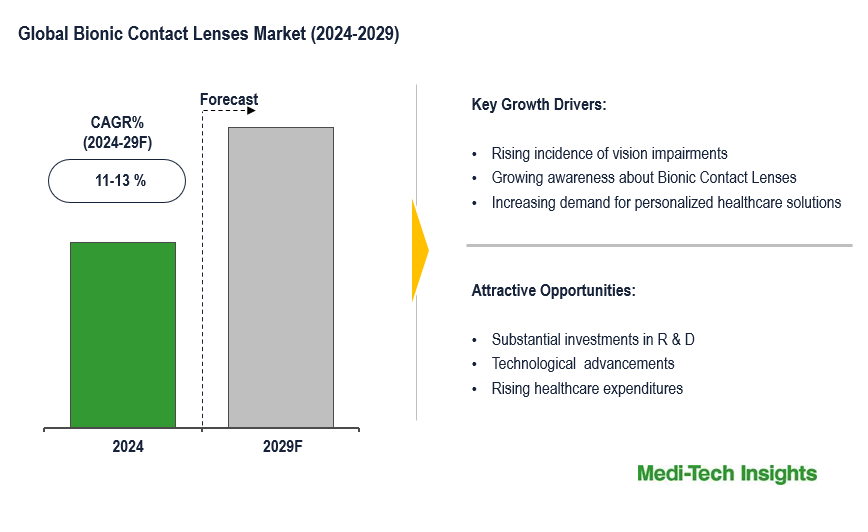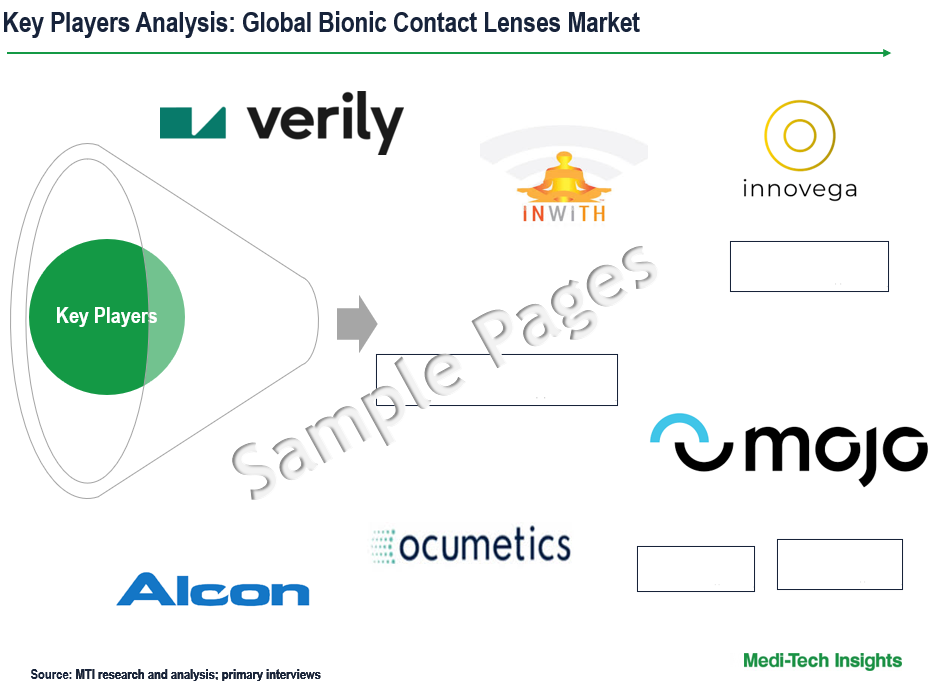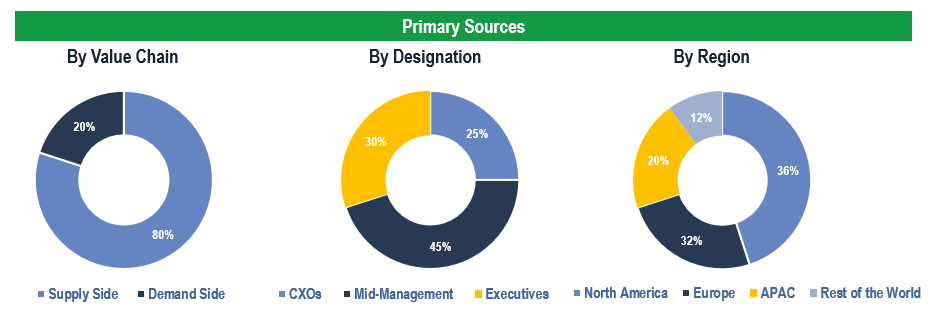
Bionic Contact Lenses Market Size, Share, Growth, and Visionary Insights for Forecast 2024 to 2029
The Bionic Contact Lenses Market is anticipated to grow at a CAGR of 11-13%. The key growth factors driving the adoption of bionic contact lenses include advancements in technology such as the miniaturization of components and integration of advanced functionalities like augmented reality and health monitoring. Additionally, the increasing demand for personalized healthcare solutions and the rising prevalence of vision impairments contribute to the growth of the bionic contact lenses market. To learn more about the research report, download a sample report.
Bionic contact lenses are a revolutionary concept that integrates advanced technology with the functionality of traditional contact lenses. These lenses hold promise for transforming the fields of vision correction and augmented reality (AR). They offer potential benefits such as correcting vision issues like nearsightedness, farsightedness, and astigmatism, while also enabling AR experiences by overlaying digital information onto the wearer's field of vision. Additionally, bionic lenses could incorporate sensors for biometric monitoring, providing valuable health data such as blood glucose levels and heart rate. Enhanced vision capabilities, including improved night vision and zoom functions, are also envisaged. Despite facing significant technological challenges, such as miniaturizing components and addressing privacy concerns, ongoing research in materials science and electronics is inching closer to realizing the vision of bionic contact lenses as a groundbreaking wearable technology.
Empowering Vision and Health: The Promise of Bionic Contact Lenses
The development and adoption of bionic contact lenses are driven by several key factors, each presenting opportunities for growth and innovation. Continuous advancements in materials science, electronics, and nanotechnology provide opportunities to miniaturize components and integrate them into contact lenses. The growing demand for vision correction solutions presents a significant opportunity for bionic contact lenses. As the global population ages and the prevalence of vision impairments increases, there is a growing need for more advanced and customizable vision correction options beyond traditional glasses and contact lenses. Incorporating healthcare monitoring functionalities into wearable devices presents a notable avenue for expansion. Bionic contact lenses equipped to monitor various biometric parameters, including blood glucose levels, intraocular pressure, or heart rate, offer valuable health insights and potential diagnostic abilities, appealing to both consumers and healthcare practitioners. These lenses are increasingly integrating advanced sensors capable of detecting specific biomarkers related to various health conditions, potentially enabling diagnostic capabilities and real-time health monitoring for users.
Bionic contact lenses offer the potential for personalized healthcare solutions tailored to individual needs. Customizable vision correction, personalized AR content, and targeted health monitoring functionalities cater to diverse user preferences and requirements, driving adoption among tech-savvy consumers and healthcare providers alike. Bionic contact lenses have the potential to improve accessibility and inclusivity for individuals with visual impairments or specific healthcare needs. By offering advanced vision correction and health monitoring functionalities in a discreet and wearable form factor, bionic contact lenses empower users to lead more independent and connected lives.

To learn more about this report, download the PDF brochure
Innovative Trends in Bionic Contact Lenses: Miniaturization, AR Enhancements, and More
Recent advancements and emerging trends in bionic contact lenses highlight the continuous evolution and promising prospects of this innovative technology. A notable trend involves the ongoing miniaturization and integration of electronic components within the lenses. Recent breakthroughs concentrate on reducing the size of sensors, displays, and wireless connectivity modules to ensure a comfortable fit on the lens surface while preserving functionality and wearer comfort. Additionally, there's a growing focus on enhancing augmented reality capabilities within bionic contact lenses. These developments feature advancements in display technologies that deliver sharper, more vibrant AR overlays. Furthermore, there have been strides in refining image processing algorithms to seamlessly integrate digital content into the wearer's field of vision, enhancing the overall AR experience.
Enhanced wireless connectivity and data transfer capabilities are becoming prominent in the development of bionic contact lenses. This involves improvements in wireless communication protocols like Bluetooth and Wi-Fi, facilitating seamless connections with smartphones, wearables, and other devices for efficient data exchange and control. Additionally, the adoption of smart materials and biocompatible coatings is emerging as a key trend in bionic contact lens evolution. Innovations in materials and surface treatments aim to enhance wearer comfort, durability, and safety by reducing friction, enhancing oxygen permeability, and mitigating the risk of irritation or infection. With ongoing research and development efforts, there is a growing focus on conducting clinical trials and seeking regulatory approval for bionic contact lenses. Recent developments include collaborations between technology companies, research institutions, and healthcare providers to conduct rigorous testing and validation of bionic lens prototypes, moving closer to commercialization and widespread adoption.
Challenges
The bionic contact lenses market faces various challenges. Firstly, the complexity of developing these lenses, which incorporate intricate technologies like miniaturized sensors and wireless connectivity, poses significant engineering hurdles. Additionally, ensuring safety and biocompatibility is crucial due to the direct contact with the eye's delicate surface. Regulatory hurdles further complicate matters, with stringent approval processes from agencies like the FDA and CE required. User acceptance hinges on comfort and usability, while concerns about privacy and security arise from features like augmented reality and health monitoring capabilities. Moreover, the high cost of development and manufacturing, coupled with the need for affordability and accessibility, presents financial challenges for market players.
Global Outlook: The Rising Demand for Bionic Contact Lenses Across Continents
The bionic contact lenses market is poised for significant growth across various regions, with North America leading the way due to the presence of major industry players advancements in technology, and substantial investments in research and development. Furthermore, favorable governmental initiatives coupled with an increasing awareness of the advantages offered by bionic contact lenses are further fueling market growth in the region. In Europe, substantial market growth is anticipated, propelled by the high prevalence of vision impairments a growing adoption of advanced healthcare solutions and significant investments in innovative technologies. Factors like an aging population and escalating healthcare expenditure are additional catalysts driving market expansion in Europe. Meanwhile, the Asia Pacific region is poised to emerge as a lucrative market for bionic contact lenses, driven by rapid technological advancements and a rising demand for vision correction solutions. Countries like China, Japan, and India are projected to experience significant market growth, fueled by factors such as increasing disposable income, expanding healthcare infrastructures, and growing awareness about eye health. Additionally, government initiatives aimed at enhancing healthcare accessibility and affordability are anticipated to further propel market growth in the region.
Competitive Landscape
Prominent players in the bionic contact lenses market include Innovega, Inwith Corp., Mojo Vision, Sony, Verily Life Sciences, Sensimed AG, Medella Health, Alcon and Ocumetrics Bionic Lens among others

Get a sample report for competitive landscape analysis
Organic and Inorganic Growth Strategies Adopted by Players to Establish Their Foothold in the Market
Players operating in this market are adopting both organic and inorganic growth strategies such as collaborations, and acquisitions to garner market share. For instance,
- In January 2022, InWith Corp. unveiled at CES what could be the most technologically advanced device for experiencing virtual worlds: an electronic soft contact lens designed for seamless transition between reality and the metaverse, prioritizing comfort and ease of use. InWith plans to release the electronic contact lens after receiving FDA approval
- In December 2019, Sensimed, a MedTech company, announced the completion of a transaction in which the Japanese public company SEED CO., LTD acquired a majority stake in Sensimed, with SEED now holding more than 90% of outstanding shares
The Bionic Contact Lenses Market is expected to gain momentum in the coming years due to the rising demand for vision correction solutions, increasing demand for augmented reality applications and personalized healthcare solutions, technological advancements, strategic collaborations and aggressive organic and inorganic growth strategies followed by the players.
Key Strategic Questions Addressed
-
What is the market size & forecast for the Global Bionic Contact Lenses Market?
-
What are the historical, present, and forecasted market shares and growth rates of various segments and sub-segments of the Global Bionic Contact Lenses Market?
-
How has COVID-19 impacted the Global Bionic Contact Lenses Market?
-
What are the major growth drivers, restraints/challenges impacting the market?
-
What are the opportunities prevailing in the market?
-
What is the investment landscape?
-
Which region has the highest share in the global market? Which region is expected to witness the highest growth rate in the next 5 years?
-
Who are the major players operating in the market? What is the competitive positioning of key players?
-
Who are the new players entering the market?
-
What are the key strategies adopted by players?
- Research Methodology
- Secondary Research
- Primary Research
- Market Estimation
- Market Forecasting
- Executive Summary
- Market Overview
- Market Dynamics
- Drivers
- Restraints
- Opportunities
- Market Dynamics
- Global Bionic Contact Lenses Market - Size & Forecast (2021-2028), By Type
- Vision Correction
- Augmented Reality (AR)
- Others
- Global Bionic Contact Lenses Market - Size & Forecast (2021-2028), By Application
- Medical
- Military
- Others
- Global Bionic Contact Lenses Market - Size & Forecast (2021-2028), By End User
- Hospitals
- Clinics
- Retail Stores
- Others
- Global Bionic Contact Lenses Market - Size & Forecast (2021-2028), By Region
- North America (U.S. & Canada)
- Europe (UK, Germany, France, Italy, Spain, Rest of Europe)
- Asia Pacific (China, India, Japan, Rest of Asia Pacific)
- Rest of the World (Latin America, Middle East & Africa)
- Competitive Landscape
- Key Players and their Competitive Positioning
- Competitive Positioning of Key Players (2022)
- Offerings Assessment, By Players
- Key Strategies Assessment, By Player (2021-2023)
- New Product Launches
- Partnerships, Agreements, & Collaborations
- Mergers & Acquisitions
- Other Developments
- Key Players and their Competitive Positioning
- Key Companies Scanned (Indicative List)
- Innovega
- Inwith Corp.
- Mojo Vision
- Sony
- Sensimed AG
- Medella Health
- Alcon
- Ocumetrics Bionic Lens
- Other Players
The study has been compiled based on extensive primary and secondary research.
Secondary Research (Indicative List)

Primary Research
To validate research findings (market size & forecasts, market segmentation, market dynamics, competitive landscape, key industry trends, etc.), extensive primary interviews were conducted with both supply and demand-side stakeholders.
Supply Side Stakeholders:
- Senior Management Level: CEOs, Presidents, Vice-Presidents, Directors, Chief Technology Officers, Chief Commercial Officers
- Mid-Management Level: Product Managers, Sales Managers, Brand Managers, Business Development Managers, Consultants
Demand Side Stakeholders:
- Stakeholders in Hospitals, Clinics, and Retail Stores among others
Breakdown of Primary Interviews

Market Size Estimation
Both ‘Top-Down and Bottom-Up Approaches’ were used to derive market size estimates and forecasts.
Data Triangulation
Research findings derived through secondary sources & internal analysis were validated with Primary Interviews, Internal Knowledge Repository, and Company Sales Data.


